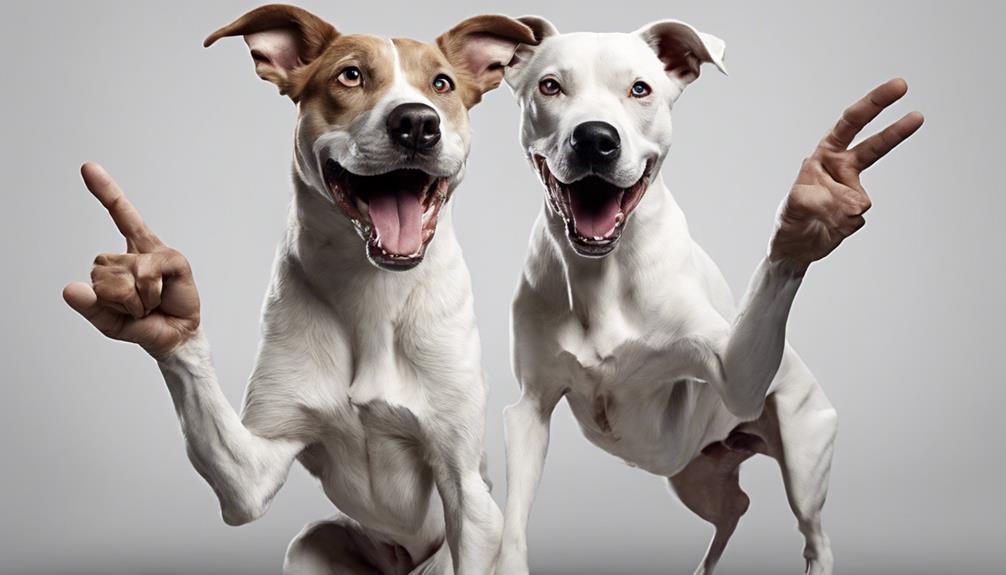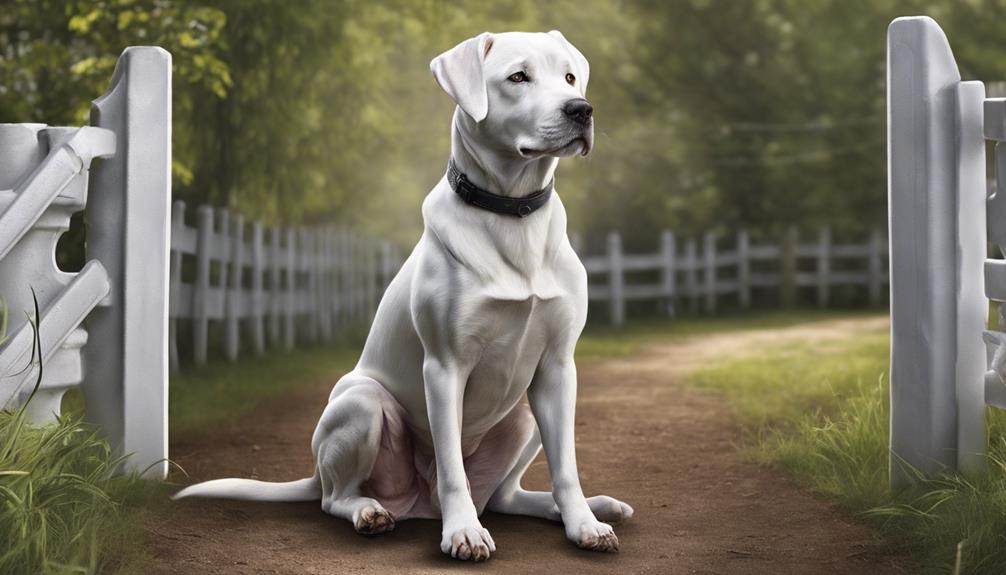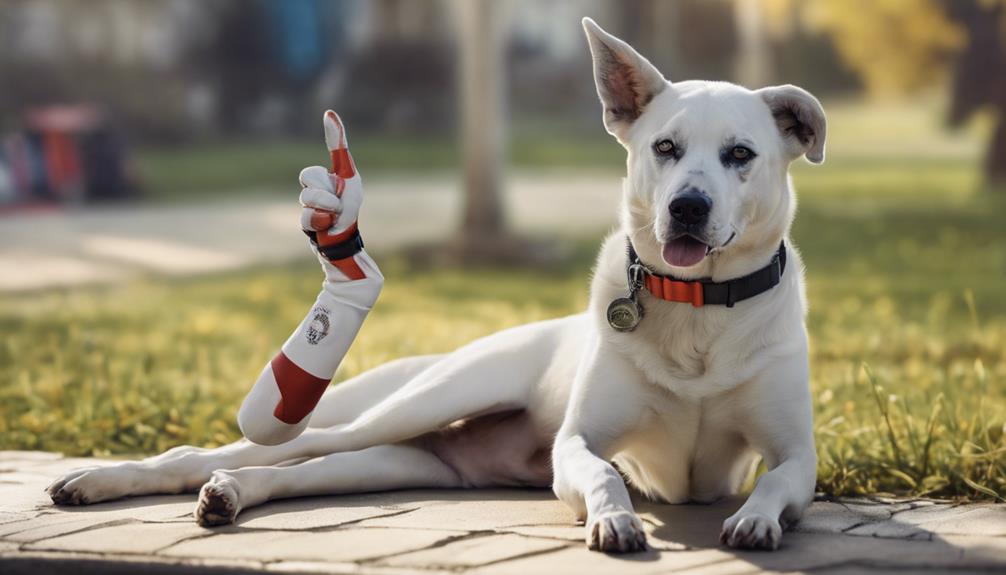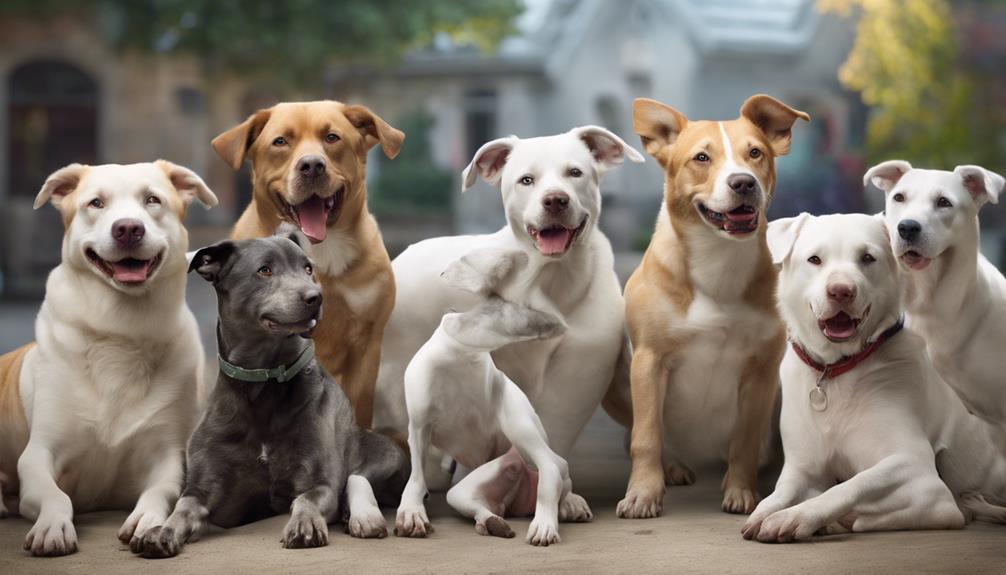When Luna, our deaf dog, continued to exhibit destructive behaviors despite our best efforts, we realized we needed to try a new strategy. Learning how to train a deaf dog can present unique challenges but can also be highly rewarding.
By exploring innovative training methods and specialized tools, we discovered effective ways to communicate and shape Luna's behavior positively. But what truly transformed our relationship with Luna was learning to think outside the box and embrace the unique bond we share.
Key Takeaways
- Use visual cues for discipline to effectively communicate with your deaf dog.
- Implement consistent hand signals to redirect unwanted behaviors positively.
- Establish clear boundaries early on to avoid confusion and reinforce positive behaviors.
- Patience, persistence, and positive reinforcement are essential for disciplining deaf dogs successfully.
Understanding Deaf Dog Behavior
Deaf dog behavior can be complex, but understanding it's key to effective training and communication. Deaf dogs heavily rely on visual cues and body language to navigate their world and interact with humans and other animals. Without the ability to hear, they may exhibit behaviors such as chewing, aggression, or challenges with socialization. It's essential to recognize that these behaviors stem from their unique communication needs and not from willful disobedience.
To effectively train deaf dogs, it's crucial to use alternative methods like hand signals for communication. Positive reinforcement is a powerful tool in shaping their behavior. By rewarding good behavior with treats, praise, or play, deaf dogs can quickly learn desired actions. Tailoring discipline techniques to suit their needs is also important. Discipline should be immediate, consistent, and fair, focusing on redirecting unwanted behaviors rather than punishment. Understanding and working with the intricacies of deaf dog behavior can lead to a strong bond built on trust and effective communication.
Importance of Visual Communication

Understanding the importance of visual communication is pivotal when disciplining a deaf dog, as it's their primary means of receiving commands and cues. Deaf dogs rely on sight to understand what's expected of them, making clear visual signals essential for effective communication. Here are some key points to consider:
- Clear Hand Signals: Using distinct hand signals helps convey commands effectively to deaf dogs, enabling them to understand and respond appropriately.
- Body Language: Incorporating expressive body language along with hand signals enhances the communication with deaf dogs, reinforcing the message being conveyed.
- Visual Cues: Deaf dogs respond well to visual cues, making it crucial to utilize gestures and movements to guide their behavior positively.
- Reinforcing Boundaries: Consistent and precise visual communication aids in reinforcing boundaries and rules for deaf dogs, establishing a structured environment for them to thrive.
Implementing Hand Signals Effectively
When implementing hand signals effectively for disciplining your deaf dog, consistency is key to successful communication. Hand signals should be clear, distinct, and consistent to ensure your deaf dog understands the commands you're giving. Using simple hand signals for different commands helps avoid confusion and aids in effective communication. It's also beneficial to train your family members and friends on the specific hand signals you use, as this can enhance communication with your deaf dog.
Combining hand signals with positive reinforcement is essential when disciplining a deaf dog. This approach helps your dog understand and respond to discipline in a positive way. By consistently using hand signals during training and discipline, you not only establish clear communication but also build a strong bond and understanding between you and your deaf dog. Remember, patience and practice are key when implementing hand signals effectively for disciplining your deaf dog.
Establishing Consistent Boundaries

Establishing consistent boundaries with your deaf dog is crucial for effective communication and positive behavior reinforcement. When it comes to dog training, especially with deaf dogs, setting clear rules and boundaries is essential for their understanding.
Here are some key points to consider:
- Consistency: Ensure that rules are consistently enforced to avoid confusion and help your deaf dog understand expectations clearly.
- Structured Environment: Creating a structured environment through consistent boundaries provides a foundation for effective communication.
- Early Reinforcement: Start establishing boundaries early on to reinforce positive behaviors and discourage unwanted actions effectively.
- Building Trust: Consistency in discipline not only helps in setting boundaries but also aids in building trust and a strong bond with your deaf dog.
Positive Reinforcement Techniques
To effectively reinforce positive behaviors in your deaf dog, utilize rewards such as treats, toys, or praise to encourage their repetition. Positive reinforcement is a powerful training tool that can help strengthen the bond between you and your deaf dog.
By rewarding good behavior promptly after it occurs, you're helping your dog make positive associations with their actions. This method is particularly effective in shaping behaviors and teaching new commands to your deaf dog. Consistency is key when using positive reinforcement techniques. By consistently rewarding desired behaviors, you can help instill lasting changes in your deaf dog's behavior.
Positive reinforcement not only helps in training your deaf dog but also fosters a sense of trust and motivation in your relationship. Remember, patience and persistence are essential when using positive reinforcement with your deaf dog. Through this method, you can create a harmonious and cooperative training environment that benefits both you and your furry companion.
Using Treats for Training

Let's continue building on the positive reinforcement techniques by exploring the effectiveness of using treats for training your deaf dog. Treats play a crucial role in motivating and rewarding your deaf dog during training sessions. Here are some key points to consider when using treats for training:
- Select High-Value Treats: Choose treats that your deaf dog loves and finds irresistible to keep them engaged and motivated during training.
- Consistency is Key: Be consistent in rewarding your deaf dog with treats for desired behaviors to reinforce learning and encourage active participation in training.
- Immediate Reward: Give treats immediately after your deaf dog displays the correct behavior to create a strong association between the action and the reward.
- Gradual Reduction: As your deaf dog becomes more proficient in responding to cues, gradually reduce the frequency of treats while still rewarding intermittently to reinforce good behavior.
Using high-value treats effectively in training can help create a positive learning environment and strengthen the bond between you and your deaf dog.
Incorporating Marker Signals

In training a deaf dog, incorporating marker signals is a vital technique to enhance communication and reinforce desired behaviors effectively. Marker signals serve as visual or tactile cues that help mark the correct behavior and signal an upcoming reward. Consistency in using these signals is key to successful training outcomes. By pairing marker signals with rewards, deaf dogs can quickly associate the signal with the desired behavior, leading to faster learning and improved communication. These signals can be as simple as a hand gesture or a light tap on the shoulder, making them easy to incorporate into training sessions. Here is a table summarizing the importance of marker signals in training a deaf dog:
| Importance of Marker Signals |
|---|
| Enhance communication |
| Reinforce desired behaviors |
| Signal upcoming rewards |
| Aid in faster learning |
| Easy to incorporate |
Building Focus and Attention

Let's focus on building a strong connection with your deaf dog through visual cues, eye contact rewards, and training in distracting environments.
By using consistent hand signals and teaching specific cues, we can help our furry friends understand when to pay attention.
Incorporating fun games like hide-and-seek can make learning to focus an enjoyable experience for both you and your deaf dog.
Use Visual Cues
When communicating with a deaf dog, incorporating visual cues like hand signals and body language is crucial. Here are some innovative ways to build focus and attention using visual cues:
- Use gentle touch to get your deaf dog's attention.
- Implement light signals to communicate specific commands.
- Try using a laser pointer to direct your dog's focus during training sessions.
- Explore options like vibrations to alert your dog to your presence.
These visual cues not only help in getting your deaf dog's attention but also establish a unique form of communication that strengthens your bond. Experiment with different techniques to find what works best for your furry companion.
Reward Eye Contact
To deepen the connection with your deaf dog and enhance their focus and attention, rewarding eye contact is a powerful technique to incorporate into your training routine. By reinforcing eye contact with treats or praise, you can encourage your deaf dog to pay attention to you willingly. This practice not only improves communication but also strengthens the bond between you and your furry companion. Positive reinforcement for eye contact sets the foundation for effective communication with your deaf dog, leading to increased training success. Below is a table highlighting the benefits of rewarding eye contact:
| Benefits of Rewarding Eye Contact |
|---|
| Builds focus and attention |
| Enhances communication |
| Strengthens bond with your dog |
| Encourages voluntary attention |
| Establishes positive reinforcement |
Practice With Distractions
While training your deaf dog, incorporating practice sessions with distractions is essential for building focus and attention.
To achieve this effectively, start in a quiet environment and gradually introduce distractions like noises or toys.
Use high-value treats to maintain your deaf dog's focus during training sessions amidst distractions.
Incorporate visual cues and hand signals to redirect attention back to you when your dog gets distracted.
Consistent practice with distractions will help improve your deaf dog's responsiveness to commands and strengthen their ability to focus even in challenging situations.
Addressing Behavioral Challenges

When addressing behavioral challenges in deaf dogs, it's crucial to utilize training techniques that focus on visual cues and hand signals for effective communication.
Implementing positive reinforcement strategies can help redirect and correct undesired behaviors in a gentle manner. Remember to avoid physical corrections that might escalate aggression and instead opt for patient redirection and distractions, considering the unique needs of deaf dogs.
Training Techniques for Behavior
When training a deaf dog to address behavioral challenges, incorporating consistent hand signals for corrections and positive reinforcement is essential for effective discipline. Deaf dogs rely heavily on visual cues, so utilizing hand signals and body language can help communicate your expectations clearly.
Here are some key techniques to consider:
- Consistent Corrections: Use the same hand signals consistently to correct unwanted behaviors.
- Immediate Rewards: Reward positive behaviors promptly to reinforce good conduct.
- Avoid Physical Corrections: Steer clear of physical corrections that may lead to aggression in a deaf dog.
- Consistency is Key: Maintain consistency in your training methods to effectively manage and address behavioral challenges in your deaf dog.
Communication Strategies for Correction
To effectively address behavioral challenges in your deaf dog, incorporating clear hand signals and positive reinforcement techniques is crucial. Clear hand signals help your deaf dog understand commands and corrections, creating a strong communication bridge. Positive reinforcement, such as treats or toys, redirects unwanted behaviors effectively without causing stress. It's essential to avoid physical corrections that can lead to further issues. Creating a safe and positive environment is key to encouraging desired behaviors in your deaf dog. Check out the table below for a summary of effective communication strategies for correcting your deaf dog's behavior.
| Communication Strategies for Correction |
|---|
| Use consistent hand signals |
| Implement positive reinforcement |
| Avoid physical corrections |
| Incorporate redirection methods |
| Focus on creating a safe environment |
Socialization Strategies for Deaf Dogs

In socializing deaf dogs, it's essential to mimic a mother dog's discipline techniques to effectively guide their interactions with other dogs. When socializing a deaf puppy, using hand signals and the Power of Positive reinforcement can be incredibly beneficial. Here are some strategies for successfully socializing deaf dogs:
- Monitor Interactions: Keep a close eye on interactions with other dogs and step in when necessary to guide proper behavior.
- Redirect Play: Use toys to redirect play and biting behavior, encouraging positive socialization experiences.
- Avoid Excessive Corrections: Refrain from excessive corrections during socialization to prevent negative associations with social interactions.
- Be Patient: Understand the age and impressionability of a deaf puppy during the socialization process, and practice patience throughout.
Seeking Professional Training Assistance

When it comes to disciplining a deaf dog, seeking professional training assistance can make a significant difference. Trainers with expertise in positive reinforcement methods tailored for deaf dogs can offer valuable insights and techniques.
Working with a professional can enhance communication and understanding between you and your deaf dog.
Trainer Qualifications
Considering trainers experienced in working with deaf dogs is crucial to ensure effective and tailored training methods. When seeking professional assistance, keep these points in mind:
- Look for trainers who understand the unique communication needs of deaf dogs.
- Seek professionals who can create customized training plans focusing on visual cues and positive reinforcement.
- Consider trainers with certifications or expertise in deaf dog behavior.
- Professional trainers can help address specific discipline challenges and enhance your understanding of deaf dog behavior.
Working with knowledgeable and skilled trainers won't only improve your deaf dog's discipline but also strengthen the bond between you and your furry companion.
Training Program Options
Trainers experienced in working with deaf dogs play a crucial role in developing effective and tailored training programs for disciplining your furry companion. Seeking professional training assistance can provide specialized guidance for addressing the specific behavioral challenges that deaf dogs may present.
These trainers can incorporate hand signals or even American Sign Language into their programs to communicate commands and expectations clearly to your deaf dog. By enrolling in a specialized training program, you can ensure that discipline techniques aren't only appropriate but also humane for your deaf dog.
Professional trainers offer valuable insights and strategies for managing and correcting behavior issues, focusing on positive reinforcement methods that are tailored to the unique needs of deaf dogs.
Frequently Asked Questions
How Do You Discipline a Deaf Dog?
When disciplining a deaf dog, we rely on visual cues and gestures instead of verbal commands. By using gentle touch, body language, and positive reinforcement, we can correct behavior effectively.
Consistency and patience are crucial in ensuring our furry friend understands our expectations. Remember, discipline should always be a positive teaching experience for our deaf dogs, fostering a strong bond built on trust and understanding.
How Do You Teach a Deaf Dog Commands?
When teaching commands to a deaf dog, consistency and positive reinforcement are key. Visual cues like hand signals or light signals can effectively convey commands. Repetition paired with rewards helps solidify understanding.
Family and friends should be trained to use the same hand signals to maintain consistency. Remember, patience and encouragement go a long way in helping a deaf dog learn commands successfully.
How Do You Train a Deaf Dog to Not Be Aggressive?
When training a deaf dog to not be aggressive, we focus on positive redirection. We avoid physical corrections and instead use gentle guidance or hand signals.
By offering distractions and toys, we shift their focus to positive behaviors. Creating a positive environment during confinement is crucial to prevent triggering aggression.
With young deaf puppies, alternative training methods may be necessary as traditional corrections mightn't be as effective.
Are Deaf Dogs Hard to Train?
Deaf dogs aren't inherently harder to train than hearing dogs. They require visual cues and consistent hand signals for effective communication. By understanding their needs and relying on positive reinforcement, training a deaf dog can be a rewarding experience.
It's all about patience, creativity, and adapting your training methods to suit their unique abilities. With the right approach, deaf dogs can learn just as well as any other dog.
Can Discipline Techniques for Deaf Dogs Help Reduce Barking?
Discipline techniques for understanding deaf dog barks can be effective in reducing excessive barking. Positive reinforcement and hand signals are useful tools in training deaf dogs. Consistent training and rewarding desired behaviors can help deaf dogs understand when barking is not necessary.
Conclusion
In the world of training deaf dogs, patience isn't just a virtue, it's a necessity. Like a symphony conductor guiding his orchestra, we must use visual cues and positive reinforcement to create harmony in our furry companions' lives.
By understanding their unique needs and building a strong bond through communication, we can navigate any behavioral challenge that comes our way.
So, let's continue to be the maestro of our deaf dogs' training journey, leading them to a life filled with love and understanding.











